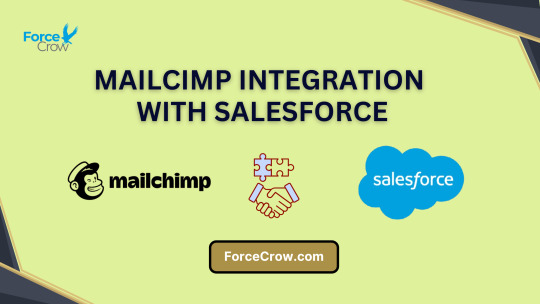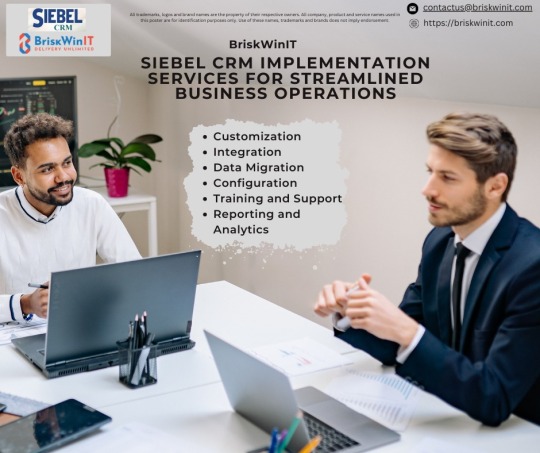#CRMintegration
Explore tagged Tumblr posts
Text
With Unified Communication Services, get seamless #integration across channels: 🔹 Cross-channel integration for smooth #communication. 🔹 Intelligent #callrouting for smarter service. 🔹 CRM integration for enhanced efficiency. 🔹 Advanced #analytics to optimize performance.
Ready to streamline your communication? Let’s simplify your workflow today: https://www.vitelglobal.com/ucaas
#UnifiedCommunication#CrossChannel#SmartRouting#CRMIntegration#AdvancedAnalytics#VitelGlobal#Efficiency#USA#UCaaS
5 notes
·
View notes
Text
𝐒𝐮𝐩𝐞𝐫𝐜𝐡𝐚𝐫𝐠𝐞 𝐘𝐨𝐮𝐫 𝐌𝐚𝐫𝐤𝐞𝐭𝐢𝐧𝐠 𝐰𝐢𝐭𝐡 𝐌𝐚𝐢𝐥𝐜𝐡𝐢𝐦𝐩 + 𝐒𝐚𝐥𝐞𝐬𝐟𝐨𝐫𝐜𝐞 𝐈𝐧𝐭𝐞𝐠𝐫𝐚𝐭𝐢𝐨𝐧!
Ready to take your marketing efforts to the next level? 🌟 With Mailchimp Integration with Salesforce, you can seamlessly sync your customer data, create personalized email campaigns, and drive higher engagement! 📈✨
💡 Improve your ROI with real-time data updates, boost customer targeting, and streamline your marketing strategy effortlessly! 🎯
Want to know how? 👉 𝐂𝐥𝐢𝐜𝐤 𝐨𝐧 𝐭𝐡𝐞 𝐜𝐨𝐦𝐦𝐞𝐧𝐭𝐬 𝐛𝐞𝐥𝐨𝐰 𝐟𝐨𝐫 𝐦𝐨𝐫𝐞 𝐢𝐧𝐟𝐨! 👇

#Salesforce#Mailchimp#EmailMarketing#CRMIntegration#MarketingAutomation#CustomerEngagement#DigitalMarketing#CRM
2 notes
·
View notes
Text
Streamlining Efficiency and Customer Satisfaction: Call Center Setup and Management Solutions
In today's fast-paced business landscape, establishing an effective call center is crucial for organizations aiming to provide exceptional customer service. A well-designed call center setup, supported by robust management solutions, can significantly enhance operational efficiency, improve customer satisfaction, and boost overall business success. This article delves into the key components of a successful call center setup and explores innovative management solutions that can optimize performance and ensure customer-centric operations.

1. Strategic Planning and Infrastructure:
A successful call center setup begins with meticulous strategic planning. Understanding the organization's objectives, target audience, and service requirements is essential for designing an efficient infrastructure. Considerations such as call volume projections, necessary hardware and software, telephony systems, and network infrastructure must be carefully assessed. Advanced technologies like cloud-based solutions can offer scalability, flexibility, and cost-effectiveness, allowing businesses to adapt to changing demands.
2. Workforce Management:
A well-managed workforce is the backbone of any call center. Efficiently scheduling agents, forecasting call volumes, and accurately estimating staffing needs are crucial for maintaining service levels and minimizing wait times. Workforce management solutions leverage sophisticated algorithms to optimize scheduling, taking into account historical data, employee skills, and service level agreements. These tools enable organizations to strike a balance between customer demand and agent availability, enhancing productivity and reducing costs.
3. Quality Monitoring and Training:
To ensure consistent service quality, call centers must invest in robust quality monitoring and training programs. Implementing call recording and evaluation systems enables supervisors to assess agent performance, identify areas for improvement, and deliver targeted coaching and training. Real-time monitoring tools provide immediate feedback, allowing supervisors to intervene and guide agents during customer interactions. Continuous training programs enhance agent knowledge, soft skills, and product expertise, ultimately leading to enhanced customer satisfaction.
4. Omnichannel Integration:
Modern call centers must embrace omnichannel communication to cater to customers' evolving preferences. Integrating multiple channels, such as voice, email, chat, social media, and self-service portals, enables seamless interactions across platforms. A unified agent desktop interface and intelligent routing systems direct inquiries to the most suitable agents, ensuring consistent service delivery regardless of the channel. Omnichannel integration improves customer convenience, reduces resolution times, and fosters a personalized and consistent customer experience.
5. Analytics and Performance Metrics:
Data-driven insights play a pivotal role in optimizing call center operations. Advanced analytics tools can track key performance metrics, such as average handling time, first call resolution, customer satisfaction scores, and agent productivity. Analyzing this data helps identify operational bottlenecks, gauge customer sentiment, and make informed decisions. Predictive analytics can even anticipate customer needs, allowing agents to proactively address concerns and improve overall service levels.
6. Continuous Improvement and Feedback Loops:
A culture of continuous improvement is vital for the long-term success of any call center. Regularly seeking feedback from customers and agents alike helps identify pain points and areas of improvement. Employee engagement programs, feedback mechanisms, and recognition initiatives create a positive work environment and motivate agents to deliver exceptional service. By fostering a feedback loop, call centers can adapt to changing customer expectations, refine processes, and innovate to stay ahead in a competitive market.
Conclusion:
Setting up and managing a call center involves a multifaceted approach that blends strategic planning, technology implementation, and effective management solutions. By prioritizing infrastructure, workforce management, quality monitoring, omnichannel integration, analytics, and continuous improvement, businesses can establish customer-centric call centers that drive operational efficiency and enhance customer satisfaction. Embracing innovative solutions and staying attuned to evolving industry trends will position organizations for success in an increasingly competitive business landscape.
Click here to check my service on Fiverr
Source:
#CallCenterSetup#CallCenterManagement#CustomerService#ContactCenter#CustomerExperience#Outsourcing#BusinessSolutions#CustomerSupport#ServiceManagement#InboundCallCenter#OutboundCallCenter#VirtualCallCenter#OmnichannelSupport#CRMIntegration#AgentTraining#EfficiencyImprovement#QualityAssurance#PerformanceMetrics#CostOptimization#TechnologyIntegration#WorkforceManagement#Analytics#ProcessImprovement#CustomerSatisfaction#ServiceLevelAgreement
8 notes
·
View notes
Text










Exploring Salesforce integration? Discover strategies upping efficiency by 25% and join the 60% of businesses integrating. Need expert guidance? GetOnCRM has your back!
#salesforce#crmintegration#salesforce integration#salesforce solutions#technology#salesforce partner#getoncrm
2 notes
·
View notes
Text
5 Reasons to Build a Custom CRM

A CRM system is an essential tool for businesses to manage customer interactions effectively. There are numerous CRM software options available in the market.
In this article, we’ll delve into five reasons why it’s wise to invest in building a custom CRM. Firstly, custom CRMs are tailored to meet specific business needs and workflows, leading to more efficient processes and increased productivity. Secondly, custom CRMs offer enhanced security measures and better data privacy protection. Thirdly, a custom CRM can integrate seamlessly with your existing systems, providing a unified view of customer data.
Finally, building a custom CRM can be more cost-effective in the long run, as businesses can avoid ongoing licensing fees and expensive customization costs associated with off-the-shelf software.
Unique Functionalities One of the primary benefits of creating a custom CRM system is the ability to add unique functionalities that are customized for your business. Pre-built CRM software may not provide the flexibility required to tailor your customer interactions and user experience. With a custom CRM, you can add personalized dashboards, customized reports, and workflows that match your business processes.
This can significantly improve productivity and efficiency, as well as provide a competitive advantage over businesses that use generic CRM solutions.
Integration with Another System Building a customized CRM system provides an opportunity to integrate it seamlessly with other essential business systems. Pre-packaged CRM solutions may not offer the required level of integration, which can lead to disconnected data silos and inefficient processes. A bespoke CRM solution can be designed to work in tandem with other critical systems, such as ERP, accounting, and marketing automation software.
This creates a unified view of customer data, streamlines operations, and eliminates manual data entry errors. Customized integrations also help automate repetitive tasks, freeing up valuable employee time.
Security Data One of the most significant advantages of creating a custom CRM system is the ability to implement robust security measures to protect customer data. Pre-built CRM software can have vulnerabilities that leave customer data at risk of external threats, which can compromise customer trust.
A custom-built CRM system allows businesses to design security protocols and data privacy policies that align with their specific needs. This includes implementing encryption, access control, and data backup and recovery measures.
Eases Scaling Process Creating a custom CRM solution can help businesses ease the scaling process as they grow. As a company expands, its customer management requirements become more intricate, and out-of-the-box CRM software may not be adequate to handle the increased workload.
With a customized CRM solution businesses can tailor their CRM system to meet their evolving needs, adding features, functionalities, and integrations as required without switching to a new CRM platform entirely.
What is CRM Application Development? CRM application development is the process of building a customized customer relationship management system for businesses. Such systems are designed to help businesses manage their customer interactions, optimize their sales and marketing processes, and improve customer retention rates. Although there are off-the-shelf CRM solutions available, a custom CRM application provides businesses with a bespoke solution that caters to their unique needs.
The development process for a custom CRM application typically involves several stages. Firstly, a comprehensive analysis is conducted to understand the specific challenges and opportunities that the CRM system needs to address. This includes an evaluation of the current processes, data structures, and integrations that are in place.
Next, the development team creates a customized solution that addresses the identified challenges and opportunities. This may involve the creation of new features, the integration of existing software and systems, and the implementation of tailored security and privacy measures.
The coding and testing phases follow the design phase, with the development team creating the software and testing it thoroughly to ensure that it meets the business’s requirements and functions correctly.
Conclusion Creating a customized CRM solution provides businesses with a wide range of benefits that cannot be found in off-the-shelf CRM software. A tailored CRM application offers unique features and functionalities that address a business’s specific needs, enhancing the effectiveness and efficiency of its sales and marketing processes.
Moreover, Custom CRM Applications can be seamlessly integrated with existing software and systems, streamlining operations and saving time and resources. Additionally, custom CRM systems offer advanced security features that protect customer data, reducing the risk of data breaches and ensuring compliance with data protection regulations.
#crm software#crm development#crm solutions#crm software development company#CRM Software Development Service#crm implementation#crmintegration#CRM#crm development company#web development company#web development services
3 notes
·
View notes
Text

Are you ready to take your business to the next level? Our Siebel CRM implementation services are designed to streamline your operations, optimize your customer interactions, and propel your organization towards unprecedented success.
#SiebelCRMExperts#CRMImplementationServices#CRMTransformation#StreamlineYourBusiness#EfficientCRMSystems#CustomerSuccessJourney#CRMStrategy#DigitalTransformation#CRMIntegration#CRMConsulting#MaximizeCustomerValue#AccelerateBusinessGrowth#CRMCustomization#CRMUpgrade
3 notes
·
View notes
Text
Integrating Salesforce? Watch out for these 7 common pitfalls and learn how to avoid them! Inadequate planning, data management challenges, poor user adoption, and more. Discover the best strategies to overcome these obstacles and achieve a seamless Salesforce integration with GetOnCRM expertise.
#salesforce integration#salesforce#crmintegration#crm solution#businessimpact#data integration#data management#salesforce partner#technology#getoncrm
3 notes
·
View notes
Text

Seamless CRM Integration for Streamlined Business Operations! Enhance your workflow with CRM Integration and skyrocket your productivity! Don't miss out on this game-changing opportunity! Click the link in the bio to learn more! Website:- https://www.ringflow.com/ Email:- [email protected]
#CRMIntegration#BusinessSolutions#ProductivityBoost#DigitalTransformation#ClickLinkInBio#BusinessSuccess#StreamlinedOperations#EfficiencyMatters
1 note
·
View note
Link
0 notes
Text

Scan and import WhatsApp numbers instantly. No more manual saving—automate follow-ups and boost conversions with WA Bridge! . . 💸 Starting from just 149 AED/month!
📲 Book your FREE demo now!
📞 +971-507124632 📧 [email protected] 🌐 wabridge.com
#WABridge#WhatsAppMarketing#AutoImport#WhatsAppAutomation#CRMIntegration#LeadFollowup#WAChatTool#DigitalMarketing#BusinessTools#WhatsAppAPI
0 notes
Text
Integrating Third-Party Tools into Your CRM System: Best Practices
A modern CRM is rarely a standalone tool — it works best when integrated with your business's key platforms like email services, accounting software, marketing tools, and more. But improper integration can lead to data errors, system lags, and security risks.

Here are the best practices developers should follow when integrating third-party tools into CRM systems:
1. Define Clear Integration Objectives
Identify business goals for each integration (e.g., marketing automation, lead capture, billing sync)
Choose tools that align with your CRM’s data model and workflows
Avoid unnecessary integrations that create maintenance overhead
2. Use APIs Wherever Possible
Rely on RESTful or GraphQL APIs for secure, scalable communication
Avoid direct database-level integrations that break during updates
Choose platforms with well-documented and stable APIs
Custom CRM solutions can be built with flexible API gateways
3. Data Mapping and Standardization
Map data fields between systems to prevent mismatches
Use a unified format for customer records, tags, timestamps, and IDs
Normalize values like currencies, time zones, and languages
Maintain a consistent data schema across all tools
4. Authentication and Security
Use OAuth2.0 or token-based authentication for third-party access
Set role-based permissions for which apps access which CRM modules
Monitor access logs for unauthorized activity
Encrypt data during transfer and storage
5. Error Handling and Logging
Create retry logic for API failures and rate limits
Set up alert systems for integration breakdowns
Maintain detailed logs for debugging sync issues
Keep version control of integration scripts and middleware
6. Real-Time vs Batch Syncing
Use real-time sync for critical customer events (e.g., purchases, support tickets)
Use batch syncing for bulk data like marketing lists or invoices
Balance sync frequency to optimize server load
Choose integration frequency based on business impact
7. Scalability and Maintenance
Build integrations as microservices or middleware, not monolithic code
Use message queues (like Kafka or RabbitMQ) for heavy data flow
Design integrations that can evolve with CRM upgrades
Partner with CRM developers for long-term integration strategy
CRM integration experts can future-proof your ecosystem
#CRMIntegration#CRMBestPractices#APIIntegration#CustomCRM#TechStack#ThirdPartyTools#CRMDevelopment#DataSync#SecureIntegration#WorkflowAutomation
0 notes
Text
Click to Dial is a powerful telephony interface feature that enables users to initiate phone calls directly from a digital interface—such as a CRM, email, website, or desktop application—by simply clicking on a phone number. Instead of manually dialing or switching between screens, Click to Dial streamlines the calling process by connecting the call directly to the user’s phone.
0 notes
Text

Supercharge your eCommerce workflow by integrating a custom CRM with Shopify API! 🚀 This powerful connection allows you to manage customer data, automate processes, and boost sales with real-time insights. Whether you're scaling or streamlining, a tailored CRM solution can give you a serious edge.
0 notes
Text
Setting Up a Virtual Call Center: Revolutionizing Customer Service
Customer service is an essential component of any successful business. It plays a crucial role in ensuring customer satisfaction and building long-term relationships with clients. Traditionally, call centers have been the backbone of customer service, but with the advancements in technology, a new trend is emerging - virtual call centers.
A virtual call center operates differently from a traditional call center. Instead of a physical location with rows of cubicles and employees, virtual call centers allow agents to work remotely from anywhere in the world. This innovative approach offers numerous benefits for both businesses and employees.

The Benefits of a Virtual Call Center
1. Increased Flexibility: One of the most significant advantages of a virtual call center is the flexibility it provides. Agents can work from the comfort of their own homes, eliminating the need for commuting and allowing for a better work-life balance. This flexibility can lead to higher job satisfaction and increased productivity.
2. Expanded Talent Pool: When operating a traditional call center, businesses are limited to hiring agents from the local area. However, with a virtual call center, companies can tap into a global talent pool. This means they can recruit agents with specific skills and language capabilities that align with their customer base, ultimately enhancing the overall quality of customer service.
3. Cost Savings: Setting up and maintaining a physical call center can be a significant financial investment. Rent, utilities, and equipment costs can quickly add up. By transitioning to a virtual call center, businesses can significantly reduce these expenses. There is no need for a large office space, and agents use their own equipment, reducing overhead costs substantially.
4. Scalability: Virtual call centers offer unparalleled scalability. Traditional call centers require significant planning and resources to accommodate fluctuations in call volume. With a virtual setup, businesses can easily scale their operations up or down, depending on demand. This flexibility ensures efficient resource allocation and improved customer service.
Key Considerations for Setting Up a Virtual Call Center
1. Reliable Communication Infrastructure: A robust communication infrastructure is crucial for a virtual call center. High-speed internet, reliable VoIP (Voice over Internet Protocol) systems, and effective collaboration tools are essential for seamless communication between agents and customers. Investing in reliable technology is vital to maintaining excellent customer service standards.
2. Training and Support: Virtual call center agents need comprehensive training to understand the company's products, services, and customer service protocols. Investing in online training platforms and providing ongoing support will ensure that agents are well-equipped to handle customer inquiries and resolve issues efficiently.
3. Performance Monitoring: Monitoring agent performance is essential for maintaining service quality and identifying areas for improvement. Virtual call centers can utilize various software tools to track metrics such as call duration, customer satisfaction ratings, and first-call resolution rates. Regular feedback and coaching sessions are also crucial for agent development.
4. Data Security: Protecting customer data is of utmost importance. Implementing robust security measures, such as encrypted connections and secure data storage, is necessary to maintain customer trust and comply with data protection regulations.
The Future of Customer Service
As technology continues to evolve, virtual call centers are shaping the future of customer service. They offer flexibility, cost savings, and access to a global talent pool. By embracing this innovative approach, businesses can enhance their customer service capabilities and gain a competitive edge in today's digital landscape.
While virtual call centers may not completely replace traditional call centers, they provide a valuable alternative that enables businesses to adapt to changing customer expectations and demands. As companies continue to prioritize exceptional customer service, virtual call centers will remain at the forefront of this transformative shift.
Embracing virtual call centers is not only a smart business move but also a testament to the ever-evolving nature of customer service in the digital age.
Click here to Contact me on Fiverr
Source
#CallCenterSetup#CallCenterManagement#CustomerService#ContactCenter#CustomerExperience#Outsourcing#BusinessSolutions#CustomerSupport#ServiceManagement#InboundCallCenter#OutboundCallCenter#VirtualCallCenter#OmnichannelSupport#CRMIntegration#AgentTraining#EfficiencyImprovement#QualityAssurance#PerformanceMetrics#CostOptimization#TechnologyIntegration#WorkforceManagement#Analytics#ProcessImprovement#CustomerSatisfaction#ServiceLevelAgreement
9 notes
·
View notes
Link
Discover how Salesforce is transforming the public sector with GetOnCRM expertise! In our latest infographic, we delve into the innovative ways Salesforce solutions are streamlining processes, enhancing customer service, and driving substantial efficiencies within the public sector. Unveil how technology is not just shaping the future but actively building it. Don't miss this deep dive into digital transformation - check it out!
#salesforce#CRM#salesforcesolutions#crmintegration#salesforceintegration#publicsector#crmsolutions#technology#Salesforcepartner#getoncrm
4 notes
·
View notes
Text
Empower Your Business with Click to Dial Technology
In an age where speed and convenience define customer experience, businesses need communication tools that are not only efficient but also customer-friendly. One such revolutionary tool that is transforming how businesses connect with their customers is Click to Dial. Whether you are managing a call center, sales team, or customer service desk, this simple yet powerful technology can significantly improve productivity and customer satisfaction.
At Aria Telecom, we provide advanced Click to Dial solutions that make initiating a call as easy as a single click. This feature is especially useful for businesses that rely heavily on phone communication and want to eliminate time-consuming manual dialing.
What is Click to Dial?
Click to Dial is a feature that allows users to initiate a telephone call by clicking on a number or call icon within a web interface, CRM system, or email application. It seamlessly connects your telephony system with digital platforms, allowing your team to reach out to customers without having to dial numbers manually.
For example, when a customer’s phone number is displayed on your CRM dashboard, your agent can simply click on it to initiate the call. This not only saves time but also reduces errors caused by misdialing and boosts overall efficiency.
Key Benefits of Click to Dial
Implementing Click to Dial solutions brings multiple benefits to your business:
1. Increased Agent Productivity
Manual dialing takes time and leads to agent fatigue. With Click to Dial, calls can be initiated instantly, allowing your team to handle more calls in less time.
2. Fewer Dialing Errors
When numbers are dialed manually, there is always the risk of mistakes. Click to Dial ensures that the number is correct, reducing failed call attempts.
3. Enhanced Customer Experience
Quick and efficient communication creates a positive impression. Customers appreciate swift responses, especially when they are seeking support or service.
4. Better CRM Integration
Click to Dial can be integrated with most CRM platforms, allowing agents to call directly from the customer database while automatically logging call details for future reference.
5. Improved Call Tracking and Analytics
Businesses can track call durations, outcomes, and response times, enabling better performance monitoring and training.
Use Cases Across Industries
Click to Dial isn’t just for call centers; it has applications across various industries:
Sales Teams: Reach prospects faster and improve follow-up efficiency.
Customer Support: Resolve issues quickly with one-click calling from support tickets.
Healthcare: Schedule appointments and follow up with patients conveniently.
Real Estate: Instantly connect with clients from property management tools.
E-commerce: Offer real-time customer support from web and CRM platforms.
Why Choose Aria Telecom’s Click to Dial Solutions?
At Aria Telecom, we understand the critical role that communication plays in business success. Our Click to Dial solutions are designed to integrate seamlessly with your existing telephony systems and digital tools.
Here’s what sets us apart:
Easy Integration with CRMs like Salesforce, Zoho, Freshdesk, and more.
Secure and Reliable technology infrastructure.
Real-Time Call Logging and analytics.
Customizable Interfaces for your team’s unique workflow.
24/7 Support to keep your communication running smoothly.
Whether your team is office-based or working remotely, our solution ensures uninterrupted, efficient communication.
How Click to Dial Works
Display Number on Interface: A phone number appears as a clickable link in your system.
Click to Initiate Call: Agent clicks the number to start the call.
System Connects Call: The backend system connects the agent to the recipient instantly.
Call Logs Automatically: The system logs call duration, time, and outcome for reporting.
This simple process can save your agents hours of time every week, allowing them to focus on quality conversations rather than repetitive tasks.
0 notes